Looking to calm your restless mind? Try these soothing harp melodies: Pachelbel's Canon in D, Clair De Lune, Arwen's Song, and The Swan. These classics create a tranquil atmosphere perfect for relaxation and meditation. Don't forget timeless pieces like Greensleeves and Moonlight Sonata, beautifully adapted for harp. For contemporary options, Enya's Watermark and Celtic harp lullabies offer ethereal soundscapes. The Serenade for Harp by Marcel Grandjany is a must-listen for harp enthusiasts. Each melody's unique qualities, from gentle arpeggios to flowing rhythms, can help ease anxiety and promote inner peace. Discover how these enchanting tunes can transform your relaxation experience.
Pachelbel's Canon in D
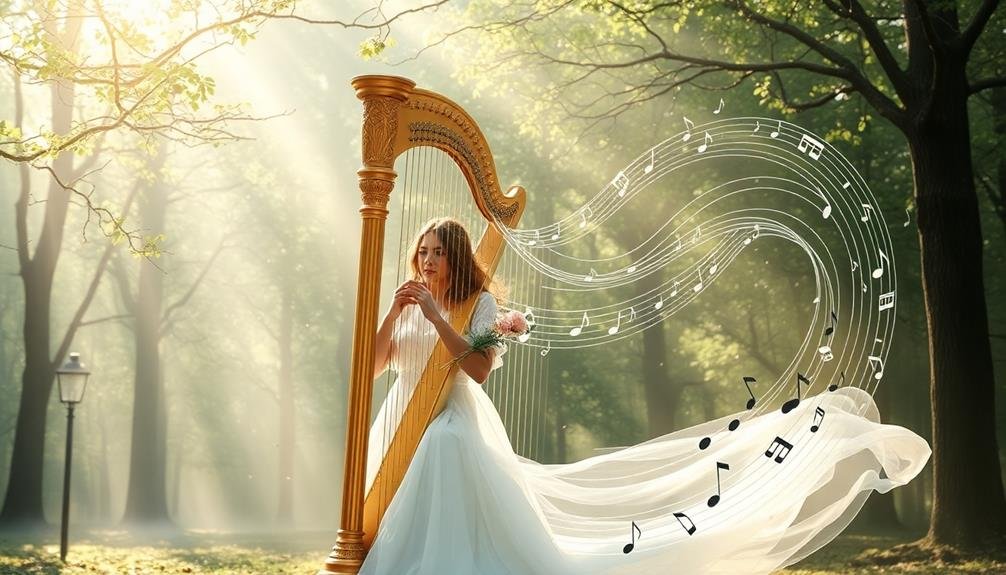
The timeless "Canon in D" by Johann Pachelbel is a go-to choice for soothing harp melodies. This Baroque masterpiece, originally composed for three violins and basso continuo, translates beautifully to the harp. Its gentle, repeating patterns create a hypnotic effect that can help calm your racing thoughts and ease your mind into a state of tranquility.
When played on the harp, Pachelbel's Canon takes on an ethereal quality. The instrument's resonant strings bring out the piece's harmonic richness, while its delicate plucking enhances the music's soothing nature. You'll find yourself drawn into the melody's gradual build-up and subtle variations, allowing your mind to focus and unwind.
This piece is particularly effective for meditation or as background music during relaxation exercises. Its steady rhythm can help regulate your breathing, making it an excellent choice for stress relief.
Whether you're struggling with insomnia, anxiety, or simply need a moment of peace in your day, listening to "Canon in D" on the harp can provide a much-needed respite from the chaos of everyday life.
Clair De Lune
As you listen to Debussy's "Clair De Lune" on the harp, you're transported to a moonlit landscape of ethereal beauty.
This timeless arrangement captures the essence of the original piano composition, with the harp's gentle strings creating a shimmering, dreamlike atmosphere.
You'll find your restless mind calming as the harp's celestial tones paint a vivid picture of tranquility and serenity.
Ethereal Moonlit Soundscape
Transcendent and otherworldly, Claude Debussy's "Clair de Lune" transforms into an ethereal masterpiece when played on the harp. As you listen, you'll find yourself transported to a moonlit landscape, where shimmering notes paint a picture of serene beauty. The harp's delicate strings capture the piece's inherent softness, enhancing its dreamlike quality.
You'll notice how the harpist's fingers dance across the strings, creating a cascading effect that mimics the gentle play of moonlight on water. The lower notes provide a solid foundation, while the higher registers twinkle like stars in the night sky. As the melody unfolds, you'll feel a sense of calm washing over you, your mind quieting with each passing measure.
The harp's unique timbre adds depth to Debussy's composition, bringing out nuances that might be overlooked in piano renditions. You'll hear subtle harmonics and overtones that create a rich, immersive soundscape.
This version of "Clair de Lune" doesn't just soothe your ears; it envelops your entire being in a cocoon of tranquility, making it an ideal choice for meditation or relaxation.
Debussy's Timeless Harp Arrangement
Originally composed for piano, Debussy's "Clair de Lune" has found new life in its harp arrangement. This timeless piece captures the essence of moonlight, transporting you to a tranquil domain. As you listen, you'll notice how the harp's delicate strings enhance the composition's dreamy quality, making it even more effective at calming your restless mind.
The harp version of "Clair de Lune" offers a unique listening experience. You'll hear the familiar melody transformed by the instrument's ethereal tones, creating a soothing atmosphere that envelops you. The gentle plucking of strings mimics the soft touch of moonlight, inviting you to close your eyes and let your worries melt away.
| Aspect | Piano | Harp |
|---|---|---|
| Tone | Crisp, clear | Ethereal, resonant |
| Texture | Percussive | Flowing, liquid |
| Emotion | Contemplative | Dreamy, otherworldly |
As you immerse yourself in this arrangement, you'll find that Debussy's masterpiece takes on new dimensions. The harp's ability to sustain notes and create shimmering harmonics adds depth to the piece, enhancing its ability to quiet your mind and transport you to a place of serenity.
Arwen's Song
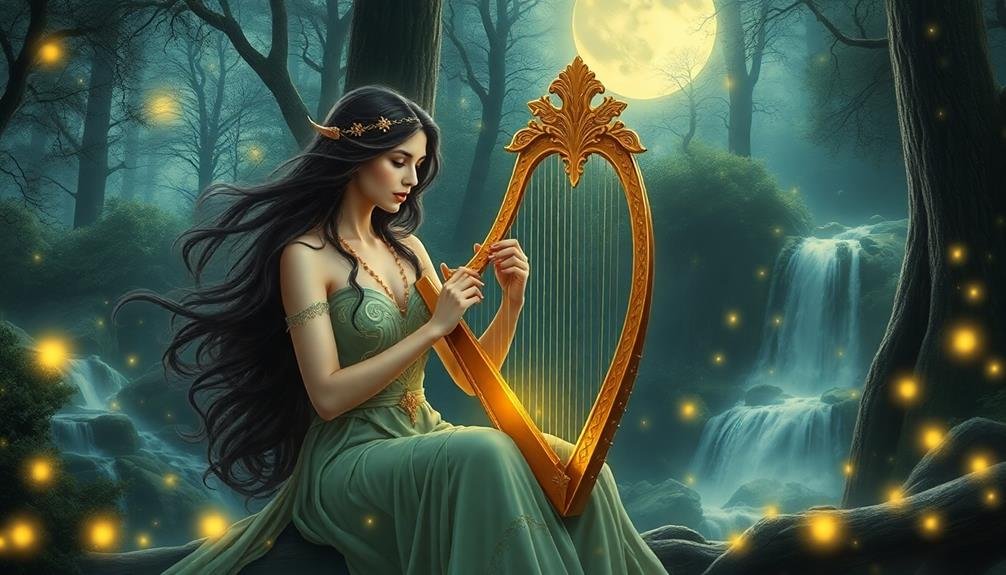
"Arwen's Song" from The Lord of the Rings films captures the ethereal beauty of elven music. Composed by Howard Shore and performed on harp, this melody transports you to the mystical domain of Middle-earth.
As you listen, you'll find yourself immersed in the gentle, flowing notes that evoke images of moonlit forests and ancient elven kingdoms.
The song's delicate harp arrangement perfectly complements Arwen's character, reflecting her grace and wisdom. You'll notice how the melody weaves a tapestry of sound, with each note carefully placed to create a sense of timelessness and longing.
The harp's resonant tones seem to whisper secrets of ages past, soothing your mind and easing your worries.
When you're feeling overwhelmed or restless, turn to "Arwen's Song" for solace. Its calming influence can help you find inner peace and tranquility.
Let the harp's enchanting melody wash over you, carrying away your cares on its gentle current. You'll discover that this piece has the power to quiet your thoughts and transport you to a domain of serenity, if only for a few precious moments.
The Swan
One of the most beloved harp melodies, "The Swan" from Camille Saint-Saëns' "The Carnival of the Animals," offers a serene and graceful listening experience. As you listen, you'll be transported to a tranquil lake where a majestic swan glides effortlessly across the water. The harp's gentle arpeggios mimic the rippling of the lake's surface, creating a soothing backdrop for the piece's main melody.
Originally composed for cello and piano, "The Swan" has been adapted beautifully for the harp. The instrument's ethereal qualities perfectly capture the swan's elegance and poise. You'll find yourself drawn into the melody's gentle ebb and flow, your mind quieting as you focus on the delicate interplay of notes.
This piece is particularly effective for meditation or relaxation exercises. As you close your eyes and let the music wash over you, you'll feel your tension melt away. The harp's resonant tones and the melody's graceful progression work together to create a peaceful atmosphere, ideal for calming a restless mind and promoting a sense of inner tranquility.
Greensleeves
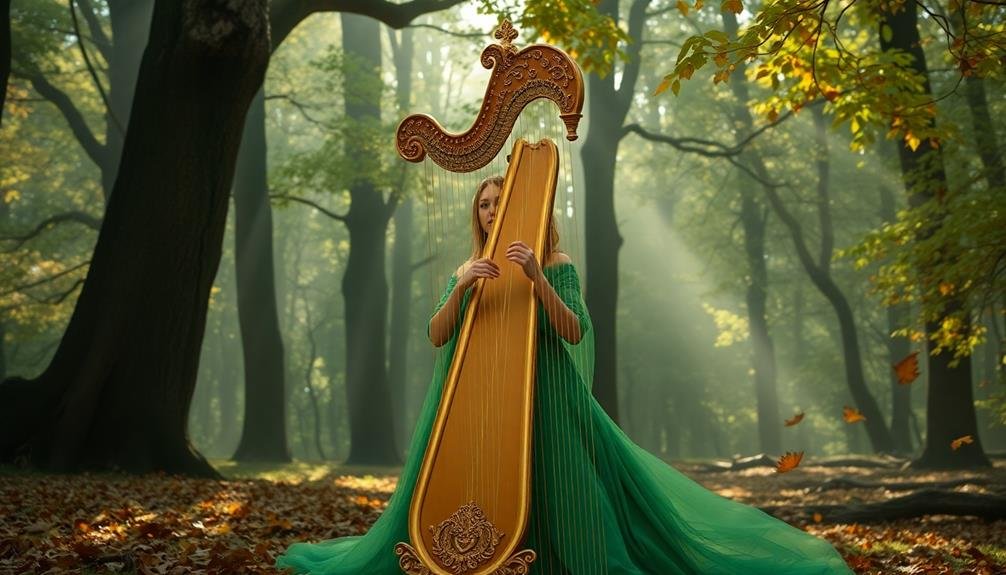
You'll find "Greensleeves" steeped in historical significance, dating back to the Tudor era.
Its gentle, flowing melody and simple harmonic structure make it an ideal piece for calming restless minds.
You can discover numerous popular harp arrangements of this timeless tune, each offering a unique interpretation of its soothing qualities.
Historical Significance
The haunting melody of "Greensleeves" carries centuries of history on its delicate notes. You'll find its origins shrouded in mystery, with legends attributing its composition to King Henry VIII for Anne Boleyn. While this romantic tale is likely untrue, the song's actual roots can be traced back to Elizabethan England in the late 16th century.
"Greensleeves" has endured through time, adapting to various musical styles and interpretations. You'll hear it in classical arrangements, folk renditions, and even as a popular Christmas carol under the title "What Child Is This?" Its timeless appeal has made it a staple in films, television shows, and commercials, often used to evoke a sense of nostalgia or old-world charm.
The song's historical significance extends beyond its longevity. It's considered a prime example of the Romanesca, a musical form popular during the Renaissance.
You'll notice its distinctive chord progression and melody have influenced countless compositions over the centuries. By listening to "Greensleeves" on the harp, you're not just experiencing a beautiful tune, but also connecting with a rich musical heritage that spans generations.
Calming Melodic Structure
Beyond its historical significance, "Greensleeves" offers a uniquely calming melodic structure that's particularly soothing when played on the harp. The song's gentle, flowing rhythm creates a hypnotic effect that can help quiet your restless mind. Its 3/4 time signature gives it a graceful, waltz-like quality that naturally lulls you into a state of relaxation.
The melody's repetitive nature, with its recognizable descending pattern, provides a sense of predictability that your brain finds comforting. As you listen, you'll notice how the harp's ethereal tones accentuate the song's calming properties. The instrument's resonant strings produce harmonics that blend seamlessly, creating a rich tapestry of sound that envelops you.
"Greensleeves" also features a balanced structure of tension and release. The verse builds a slight tension, which is then resolved in the chorus, mirroring the natural ebb and flow of your breathing.
This musical pattern subtly encourages you to synchronize your breath with the melody, further enhancing its calming effects. By focusing on the harp's delicate plucking and the song's soothing progression, you'll find your mind gradually settling into a peaceful state.
Popular Harp Arrangements
Over the centuries, numerous harp arrangements of "Greensleeves" have captivated listeners worldwide. This timeless melody has been adapted for the harp in various styles, from traditional Celtic to classical and contemporary interpretations.
You'll find that many harpists have put their unique spin on this beloved tune, creating arrangements that range from simple and soothing to complex and virtuosic.
When exploring popular harp arrangements of "Greensleeves," you'll often encounter versions that:
- Incorporate intricate fingerpicking patterns to create a flowing, water-like sound
- Use harmonics and glissandos to add ethereal, dream-like qualities to the melody
- Combine the main theme with variations and embellishments to keep the listener engaged
These arrangements often feature a slower tempo and gentler dynamics, making them ideal for relaxation and meditation.
You'll notice that skilled harpists use techniques like arpeggios and chord progressions to enhance the melody's calming effect.
Whether you're seeking a traditional rendition or a modern twist, you're sure to find a "Greensleeves" harp arrangement that resonates with you and helps quiet your restless mind.
River Flows in You
Originally composed for piano by Yiruma, "River Flows in You" has become a beloved melody that translates beautifully to the harp. The gentle, flowing nature of this piece makes it particularly well-suited for the harp's ethereal tones. When played on this instrument, the song takes on an even more soothing quality, perfect for calming restless minds.
You'll find that the harp's ability to create cascading arpeggios enhances the water-like quality of the melody, evoking images of a tranquil river. The piece's simple yet emotive structure allows harpists to infuse their own interpretation while maintaining its core essence. Many harpists have adapted this song, creating variations that range from faithful renditions to more elaborate arrangements.
As you listen, you'll notice how the harp's resonance adds depth to the piece, making it feel more immersive. The soft plucking of strings creates a delicate texture that can help ease anxiety and promote relaxation.
Whether you're seeking a moment of calm or looking to drift off to sleep, "River Flows in You" on harp offers a serene auditory experience that can transport you to a peaceful state of mind.
Moonlight Sonata
Ludwig van Beethoven's "Moonlight Sonata" takes on a dreamlike quality when adapted for the harp. As you listen, you'll find yourself transported to a serene, moonlit landscape. The harp's gentle plucking mimics the soft glow of moonbeams dancing on still waters, creating an atmosphere of tranquility and introspection.
The piece unfolds in three distinct movements, each offering a unique emotional journey:
- Adagio sostenuto: You're enveloped in a slow, haunting melody that sets the contemplative tone.
- Allegretto: The tempo quickens, providing a brief respite from the melancholy opening.
- Presto agitato: You're swept into a passionate finale, with rapid arpeggios showcasing the harp's versatility.
As you immerse yourself in this harp rendition, you'll notice how the instrument's ethereal timbre enhances the piece's emotional depth. The resonating strings create a rich tapestry of sound, allowing you to experience Beethoven's masterpiece in a new light.
Let the harp's interpretation of "Moonlight Sonata" wash over you, calming your mind and soothing your soul with its timeless beauty.
Serenade for Harp
Marcel Grandjany's "Serenade for Harp" stands out as a quintessential piece for harp enthusiasts and newcomers alike. This enchanting composition showcases the harp's ability to create a soothing atmosphere, perfect for calming restless minds. As you listen, you'll be transported to a tranquil world where worries melt away.
The piece is divided into three distinct sections, each with its own character:
| Section | Tempo | Mood |
|---|---|---|
| Opening | Moderate | Dreamy |
| Middle | Faster | Playful |
| Closing | Slow | Reflective |
You'll notice how Grandjany expertly uses the harp's full range, from delicate high notes to resonant bass tones. The flowing arpeggios and gentle glissandos create a sense of water-like movement, further enhancing the piece's calming effect.
To fully appreciate "Serenade for Harp," try listening in a quiet space with your eyes closed. Let the music wash over you, focusing on the intricate interplay between melody and harmony. You'll find that the piece's structure and pacing naturally guide your mind to a more peaceful state, making it an excellent choice for meditation or relaxation before sleep.
Enya's Watermark
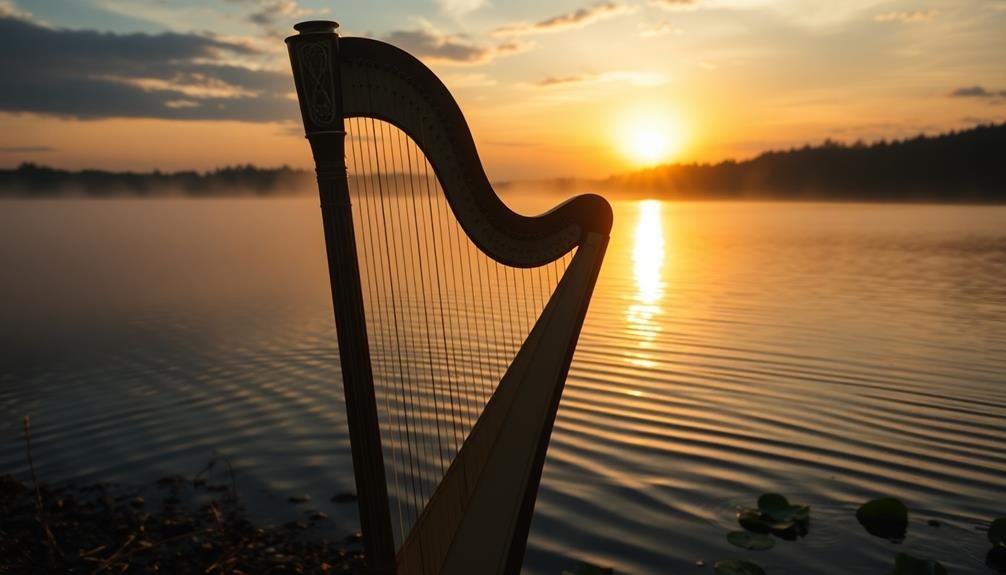
You'll instantly recognize Enya's signature harp sound in her iconic piece "Watermark."
This soothing Celtic-inspired melody weaves a tapestry of tranquility, transporting you to a serene landscape.
As a timeless relaxation classic, "Watermark" continues to calm restless minds decades after its release.
Enya's Signature Harp Sound
The ethereal, cascading harp melodies of Enya's "Watermark" have become synonymous with relaxation and tranquility. Enya's signature harp sound is a cornerstone of her unique musical style, blending Celtic influences with new-age ambiance.
You'll find that her harp techniques create a soothing atmosphere that can help calm your restless mind.
When you listen to Enya's harp-driven compositions, you'll notice three distinct characteristics:
- Layered harmonies: Multiple harp tracks are often overlaid, creating a rich, immersive soundscape.
- Gentle arpeggios: Soft, rolling patterns of individual notes contribute to the flowing, water-like quality of her music.
- Minimalist approach: Enya uses space and simplicity to enhance the impact of each harp note.
You'll find that Enya's harp melodies often incorporate elements of traditional Irish music, giving them a timeless quality.
Her use of reverb and subtle electronic effects enhances the dreamy atmosphere, making her harp sound seem to float in space.
Soothing Celtic-Inspired Melody
Enya's "Watermark" stands as a prime example of her soothing Celtic-inspired melodies. This iconic track showcases the harp's gentle, rippling tones that seem to wash over you like tranquil waves. As you listen, you'll notice how the harp's delicate plucks intertwine with ethereal synthesizers and Enya's haunting vocals, creating a mesmerizing soundscape.
The melody's repetitive nature helps calm your mind, allowing you to focus on the present moment. You'll find yourself drawn into the music's gentle ebb and flow, much like the tides suggested by the song's title. The Celtic influences are evident in the song's mystical quality and use of traditional instruments alongside modern production techniques.
"Watermark" is particularly effective for meditation or relaxation practices. Its steady rhythm can help regulate your breathing, while the layered harmonies create a sense of spaciousness in your mind. You might find that tensions in your body start to release as you immerse yourself in the music.
For best results, listen to "Watermark" in a quiet environment, allowing the harp-driven melody to transport you to a more peaceful state.
Timeless Relaxation Classic
Released in 1988, "Watermark" has stood the test of time as a quintessential relaxation classic. Enya's ethereal vocals, layered with the gentle strumming of harps, create a serene atmosphere that transports you to a tranquil domain. As you listen, you'll find your mind drifting away from daily stressors, allowing a sense of calm to wash over you.
The song's structure contributes to its soothing effect:
- It begins with a soft, melodic harp introduction that eases you into a relaxed state.
- Enya's voice enters, adding depth and warmth to the composition.
- The gradual build-up of instruments creates a rich, immersive soundscape.
You'll notice how the repetitive nature of the melody acts as a form of musical meditation, helping to quiet your restless thoughts.
The song's timeless quality means it's just as effective today as it was upon its release. Whether you're winding down after a long day, preparing for sleep, or seeking a moment of peace during a hectic schedule, "Watermark" offers a reliable retreat into tranquility.
Celtic Harp Lullaby
Soothing and ethereal, Celtic harp lullabies transport listeners to misty highlands and enchanted forests. You'll find yourself immersed in the rich musical tradition of Ireland, Scotland, and Wales as the delicate plucking of harp strings weaves tales of ancient myths and legends.
These melodic compositions often feature gentle, repetitive patterns that mimic the ebb and flow of ocean waves or the rustling of leaves in a gentle breeze. You'll notice the use of pentatonic scales and modal harmonies, creating a sound that's both familiar and otherworldly.
As you listen, you might hear hints of traditional Celtic tunes like "Skye Boat Song" or "Danny Boy" interwoven with original compositions. The harpist's nimble fingers dance across the strings, producing cascading arpeggios and shimmering glissandos that evoke images of moonlit lochs and fairy rings.
Celtic harp lullabies are particularly effective for calming restless minds due to their slow tempos and soothing timbres. You'll find your breathing naturally slowing and your muscles relaxing as you're enveloped in the warm, resonant tones of this ancient instrument.
Frequently Asked Questions
How Long Does It Take to Learn to Play the Harp?
You'll need patience to master the harp. It can take 6-12 months to learn basics, and several years to become proficient. Your dedication, practice time, and natural aptitude will influence how quickly you progress.
What Are the Different Types of Harps Available?
You'll find various types of harps available: pedal harps, lever harps, and cross-strung harps are common. There's also the Celtic harp, electric harp, and lap harp. Each type offers unique features and playing styles to suit different preferences.
Can Harp Music Help With Sleep Disorders?
Yes, harp music can help with sleep disorders. You'll find its soothing tones can calm your mind and relax your body. It's often used in music therapy to reduce anxiety and promote better sleep quality.
Are There Any Famous Harpists I Should Know About?
You'll want to know about Yolanda Kondonassis, Catrin Finch, and Xavier de Maistre. They're renowned classical harpists. For contemporary styles, check out Joanna Newsom and Deborah Henson-Conant. Each brings unique artistry to the harp.
How Much Does a Quality Harp Cost for Beginners?
You'll find quality beginner harps ranging from $500 to $5,000. Lever harps are more affordable, starting around $1,000. If you're serious about learning, consider investing in a mid-range harp around $2,000-$3,000 for better sound and durability.
In Summary
You've now explored some of the most soothing harp melodies to calm your restless mind. Whether you're drawn to classical pieces like Pachelbel's Canon or more contemporary works like Enya's Watermark, there's a harp tune to suit your taste. Don't hesitate to incorporate these beautiful melodies into your daily routine. They'll help you relax, focus, and find inner peace. Remember, the gentle strains of a harp can be your perfect companion for stress relief and tranquility.
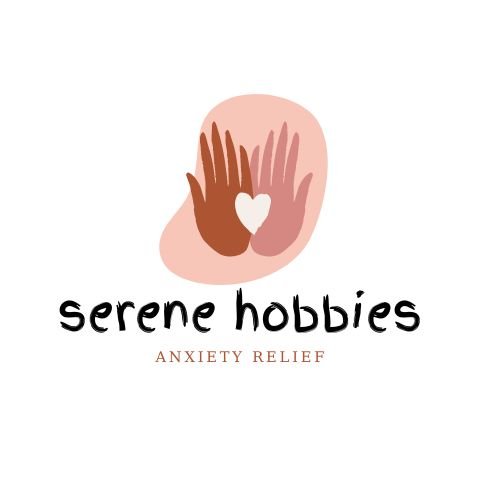
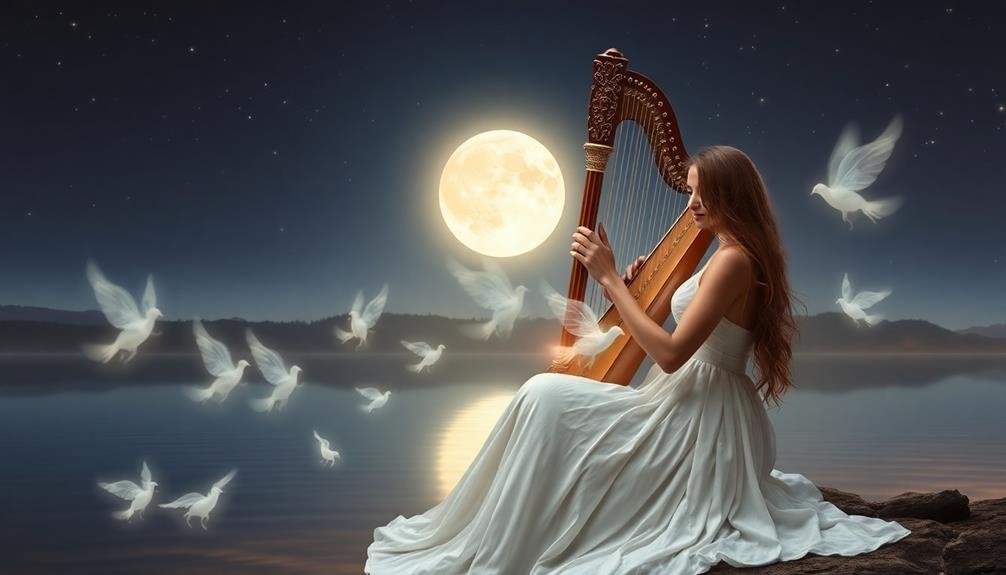



Leave a Reply